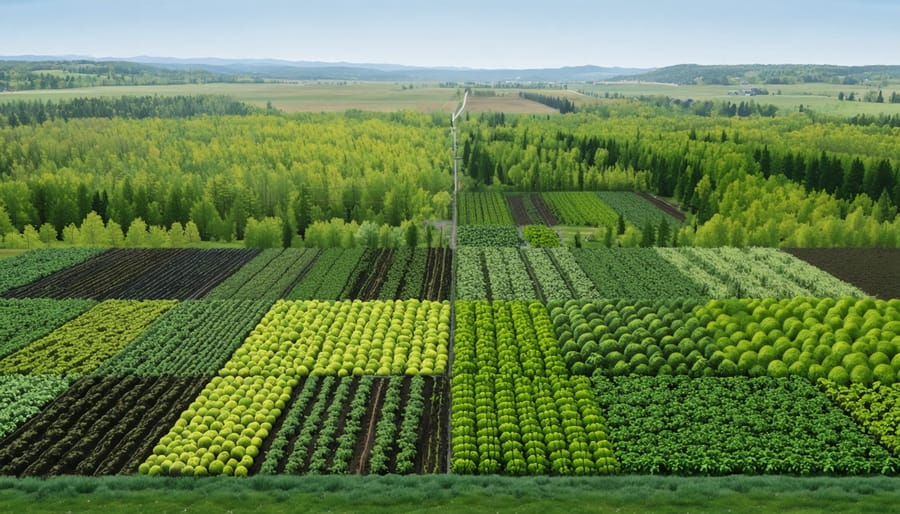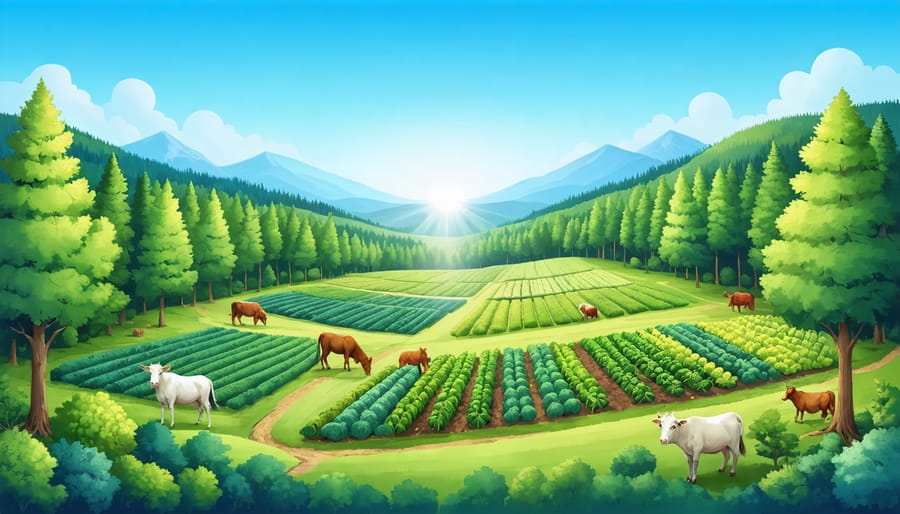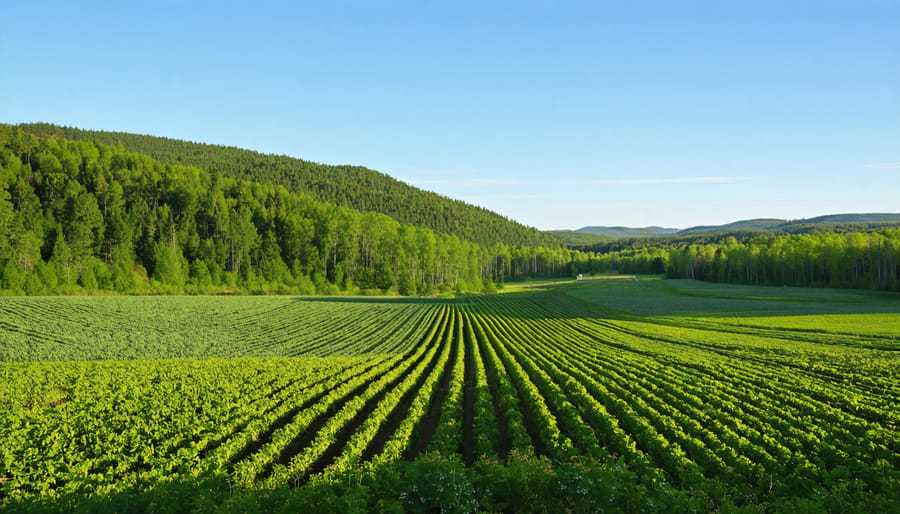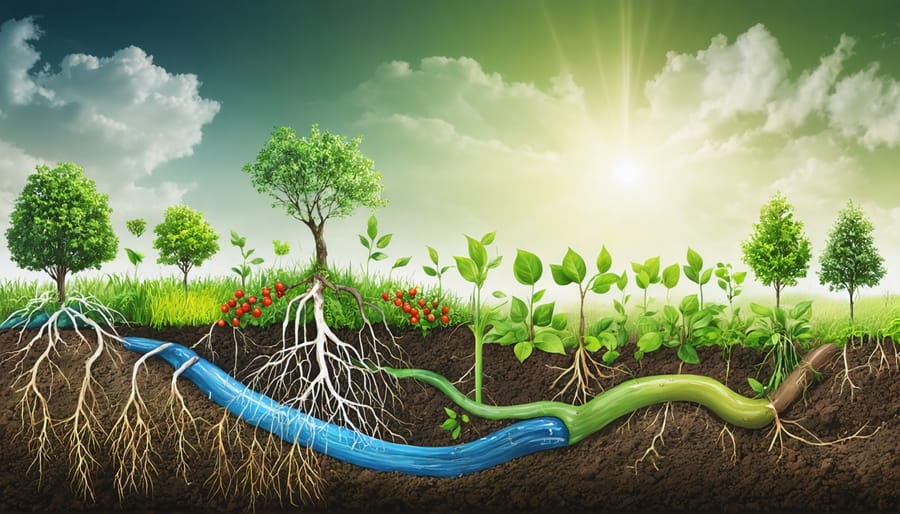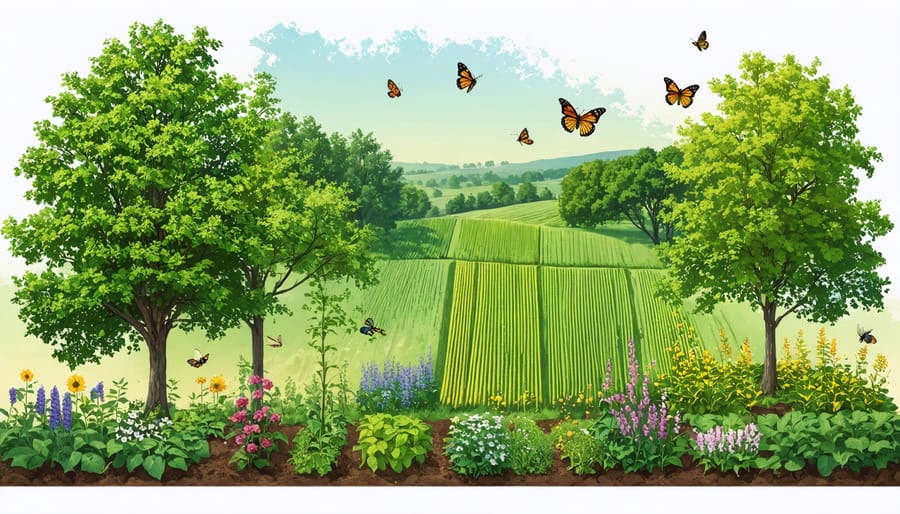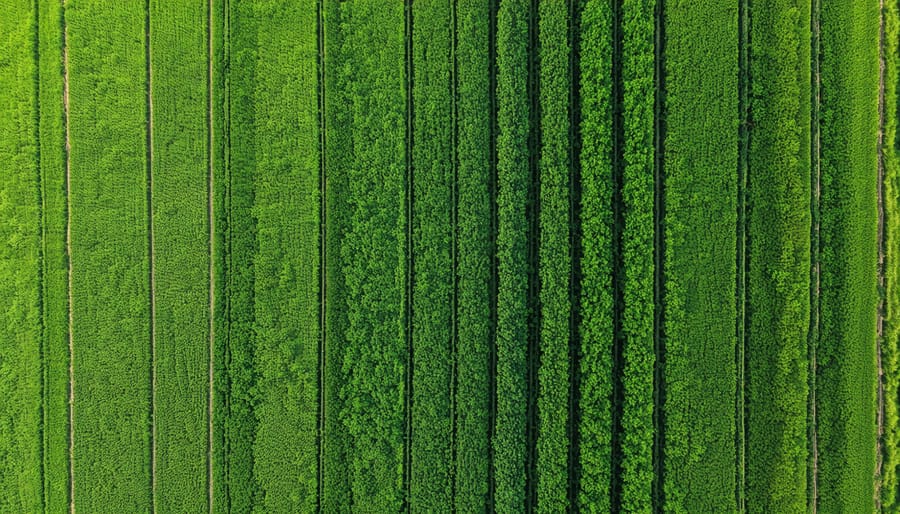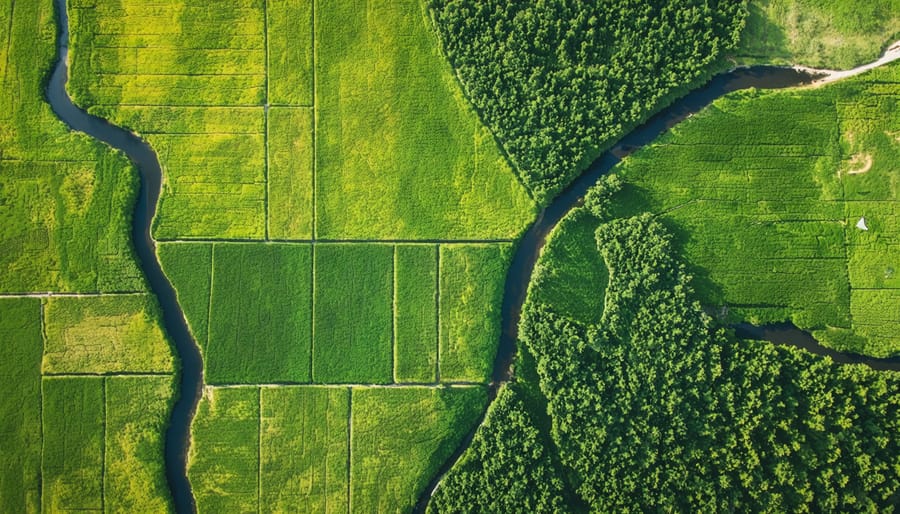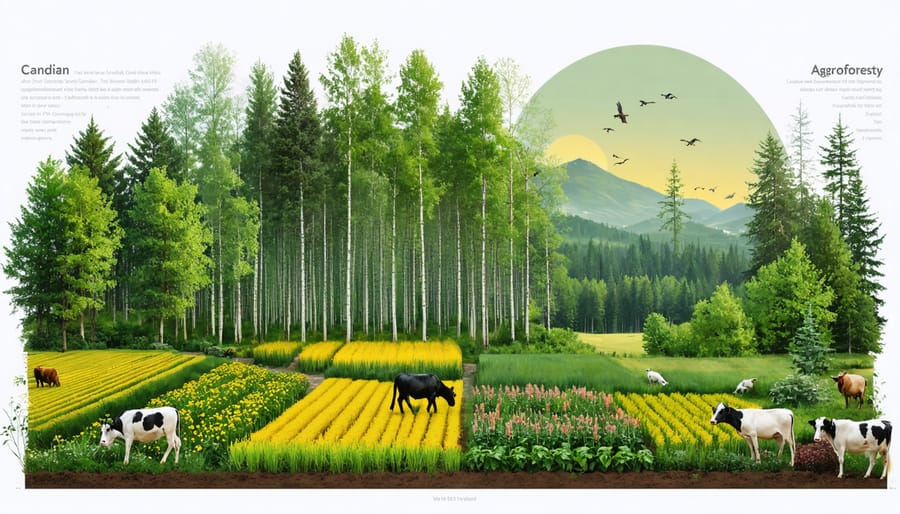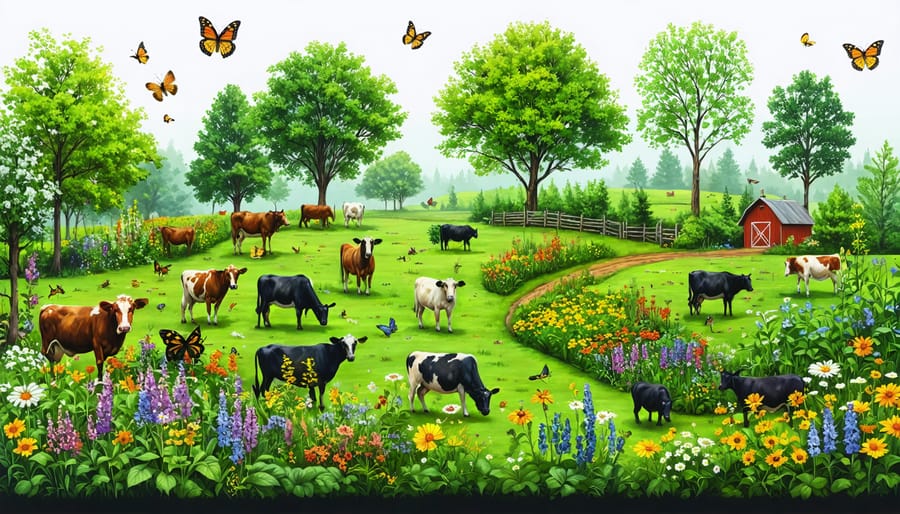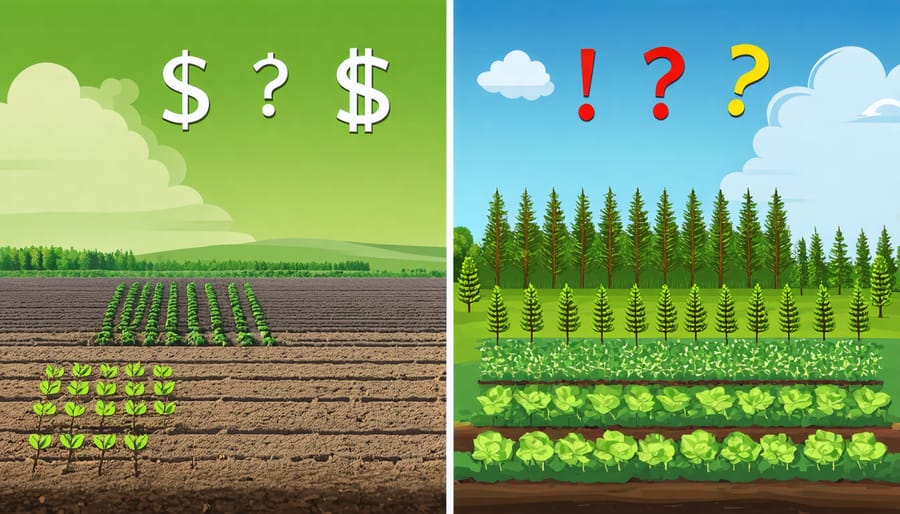Transform conventional farmland into resilient food forests by integrating native trees like trembling aspen and white spruce alongside annual crops, creating multi-layered agricultural systems that enhance climate resilience in agriculture. Plant nitrogen-fixing shrubs such as buffaloberry and silverberry between crop rows to naturally enrich soil while providing windbreaks that reduce moisture loss by up to 30% in Alberta’s semi-arid conditions. Establish fruit-bearing understory plants like saskatoon berries and chokecherries to diversify farm income streams while building wildlife corridors that strengthen local ecosystems.
Indigenous agroforestry practices have sustained communities across the Canadian prairies for generations, demonstrating how strategic tree integration can protect crops, improve soil health, and boost farm productivity. Modern agricultural operations implementing these methods report 15-25% higher yields in drought years compared to conventional monoculture systems, while sequestering an average of 5 tonnes of carbon per hectare annually.
For Alberta farmers facing increasing climate uncertainty, agroforestry offers a practical pathway to build operational resilience while maintaining profitable production. Local success stories, from small-scale market gardens to large grain operations, prove these methods work effectively within our unique growing conditions.
Proven Agroforestry Systems That Work in Alberta
Shelterbelts and Windbreaks
Shelterbelts and windbreaks are essential components of sustainable farming in Alberta’s often challenging climate. These strategically planted rows of trees and shrubs create natural barriers that protect crops, livestock, and soil from harsh winds while providing numerous environmental benefits.
A well-designed windbreak typically consists of multiple rows of different species, with tall trees forming the core and shorter shrubs on the edges. For optimal protection, windbreaks should be oriented perpendicular to prevailing winds, which in Alberta typically blow from the northwest during winter and the southeast during summer.
These living barriers can reduce wind speeds by up to 80% within protected zones, extending benefits up to 20 times the height of the tallest trees. This protection helps prevent soil erosion, reduces moisture loss, and creates better growing conditions for crops. Many Alberta farmers report 10-20% higher yields in fields protected by established shelterbelts.
Beyond crop protection, shelterbelts provide wildlife habitat, enhance biodiversity, and can serve as valuable snow traps during winter months. They’re particularly effective at reducing winter heating costs for farmsteads and improving livestock comfort in pasture systems.
For best results, consider native species like white spruce, green ash, and caragana, which are well-adapted to local conditions and provide year-round protection.
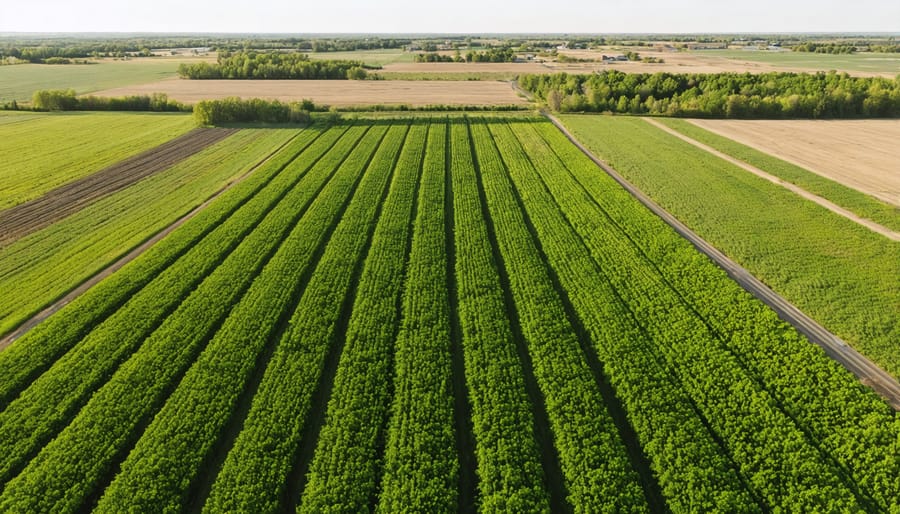
Silvopasture Success Stories
Several Alberta farmers have transformed their operations through successful silvopasture implementation. Take Dave Anderson’s farm near Red Deer, where he integrated hybrid poplar trees with rotational cattle grazing. Within five years, his livestock gained better protection from harsh winds, and he noticed a 15% increase in cattle weight gain during summer months.
In the Peace Country region, Sarah Mitchell’s operation showcases how well-planned silvopasture can thrive in northern climates. By planting white spruce windbreaks alongside pastures, she’s created microclimates that extend the grazing season by up to three weeks each year. Her cattle benefit from natural shelter, while the trees provide an additional revenue stream through sustainable harvest cycles.
The MacPherson family farm near Lacombe demonstrates how silvopasture can regenerate degraded pastureland. Their strategic planting of native willows and aspens has improved soil health, reduced erosion, and provided browse for their sheep flock. They report a 20% reduction in winter feed costs since implementing their system eight years ago.
These success stories highlight how silvopasture can enhance farm resilience while providing multiple income streams for Alberta producers.
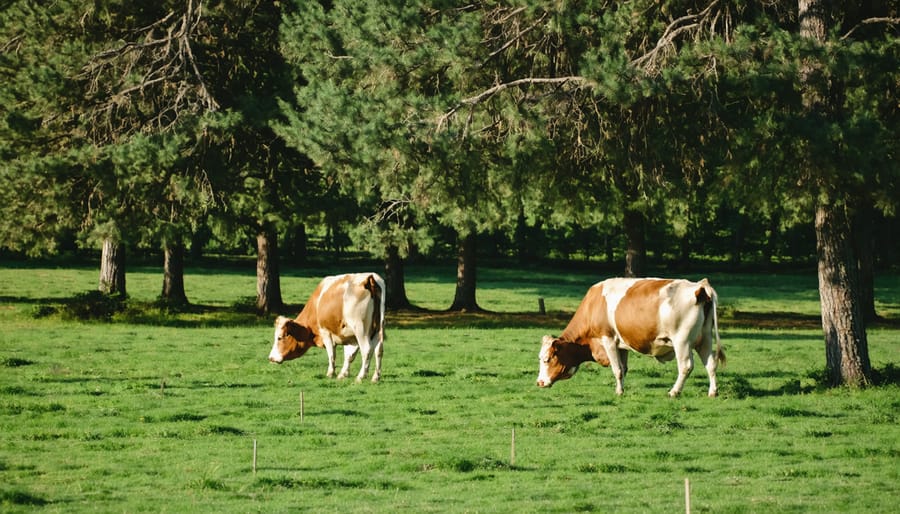
Riparian Buffers
Riparian buffers are essential strips of trees, shrubs, and grasses planted along waterways that protect both farm operations and water quality. In Alberta’s varied landscape, these natural barriers prevent soil erosion, filter agricultural runoff, and create wildlife corridors. Farmers across the province have found success with native species like willows, poplars, and red-osier dogwood, which thrive in our climate while securing riverbanks.
These buffers typically extend 10 to 30 metres from the water’s edge, though width requirements vary based on slope and soil type. Beyond erosion control, they provide additional farm benefits including wind protection for crops, natural snow fencing, and potential income from harvesting buffer plants for biomass or speciality products.
Local success stories, like the Bow River watershed project, demonstrate how riparian buffers effectively reduce nutrient runoff while supporting biodiversity and improving farm resilience to flooding events.
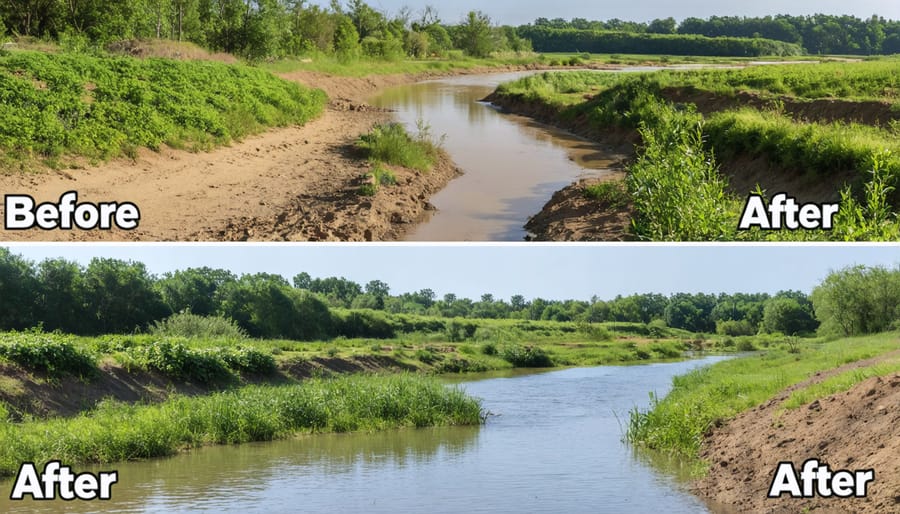
Climate Benefits You’ll See on Your Farm
Drought Protection
Trees play a vital role in protecting crops from drought conditions, making them invaluable assets in Alberta’s increasingly variable climate. The deep root systems of trees help maintain soil moisture by creating channels that allow water to penetrate deeper into the ground, effectively turning your soil into a natural reservoir.
When strategically planted, trees act as windbreaks, reducing evaporation rates across fields by up to 30%. This means more water stays where your crops need it most – in the soil. The canopy cover provided by trees also creates a microclimate that helps retain moisture by shading the ground and reducing soil temperature.
During dry spells, tree roots can access water from deeper soil layers that crops can’t reach. Through a process called hydraulic lift, trees actually pump this deep water closer to the surface at night, making it available to nearby crops. This natural irrigation system is particularly valuable in areas where water conservation is crucial.
Many Alberta farmers have noticed that fields protected by tree systems maintain better soil moisture levels throughout the growing season, requiring less irrigation and showing improved resilience during dry periods.
Soil Health Enhancement
One of the most significant benefits of agroforestry is its ability to improve soil organic matter and enhance overall soil health. When trees and shrubs are integrated into cropland or pasture systems, their deep root networks contribute to soil structure while continuously adding organic material through leaf litter and root turnover. Here in Alberta, farmers have reported up to 30% increases in soil organic carbon levels within five years of implementing agroforestry practices.
The presence of trees creates microclimates that protect soil from erosion and temperature extremes, while supporting beneficial soil microorganisms. Root systems from different plant species occupy various soil depths, maximizing nutrient cycling and carbon storage throughout the soil profile. This vertical integration helps store carbon more effectively than annual cropping systems alone.
Local studies show that shelterbelts and windbreaks can sequester between 0.8 and 1.2 tonnes of carbon per kilometre annually. Beyond carbon storage, improved soil structure leads to better water retention, reduced compaction, and enhanced nutrient availability for crops, creating a more resilient farming system that can better withstand our prairie climate extremes.
Biodiversity Gains
One of the most remarkable benefits of agroforestry is its positive impact on local biodiversity. When you integrate trees and shrubs into your farming system, you create diverse habitats that attract native pollinators like bees, butterflies, and other beneficial insects. Many Alberta farmers have reported increased crop yields due to enhanced pollination services, with some noting up to 20% improvement in canola production.
Natural pest control is another significant advantage. The varied structure of agroforestry systems provides homes for birds, bats, and beneficial insects that naturally control crop-damaging pests. For instance, chickadees and warblers commonly found in shelterbelts can consume thousands of insects daily, reducing the need for chemical pesticides.
The mixture of different plant species also creates corridors for wildlife movement and supports soil organisms that enhance nutrient cycling. Research from the University of Alberta shows that agroforestry plots typically host 30-50% more bird species than conventional fields. This increased biodiversity not only supports ecosystem health but also provides additional income opportunities through activities like beekeeping or berry production.
Getting Started: Practical Steps
Site Assessment and Planning
Before establishing an agroforestry system, carefully assessing your land and creating a detailed plan is crucial for success. Start by mapping your property, noting key features like soil types, water sources, slope aspects, and existing vegetation. In Alberta’s diverse landscape, these factors significantly influence which agroforestry practices will thrive.
Consider conducting soil tests to determine pH levels, nutrient content, and drainage patterns. Local agricultural extension offices can help interpret results and provide region-specific recommendations. Pay special attention to wind patterns and frost pockets, as these can impact tree survival and crop productivity in our climate.
When choosing your agroforestry system, factor in your farming goals, available resources, and market opportunities. For example, if you’re primarily focused on livestock, silvopasture might be your best option. If crop production is your main priority, windbreaks or alley cropping could be more suitable.
Create a timeline for implementation, keeping in mind that establishing trees takes several years. Consider starting with a small pilot project to gain experience and minimize risk. Many successful Alberta farmers recommend beginning with 1-2 hectares to test different species combinations and management approaches.
Don’t forget to check local regulations and potential funding opportunities through provincial programs. Connecting with experienced agroforesters in your area can provide valuable insights into what works best in your specific region and soil conditions.
Tree Species Selection
When selecting suitable tree varieties for Alberta’s agroforestry systems, it’s essential to consider both the local climate zones and specific farm objectives. White spruce and lodgepole pine excel in the northern regions, while hybrid poplars and green ash demonstrate remarkable adaptability across central Alberta. Manitoba maple and Siberian larch have proven particularly successful in shelterbelts and windbreaks.
For fruit production, hardy varieties like Evans cherry, Pembina plum, and native saskatoon berries offer excellent cold tolerance while providing valuable crops. These species can withstand our harsh winters while contributing to farm diversity and income streams.
Fast-growing species like hybrid willows and northwestern poplars are ideal for biomass production and riparian buffers, typically reaching harvestable size within 15-20 years. These varieties also provide excellent windbreaks and snow capture during winter months.
In southern Alberta’s drier regions, drought-resistant options like Russian olive and caragana have demonstrated remarkable resilience. However, native species like trembling aspen and bur oak often prove more beneficial for local wildlife and ecosystem health.
Remember to consider soil conditions, moisture availability, and intended tree functions when making your selection. Most successful agroforestry operations in Alberta combine three to four complementary species to maximize benefits and minimize risks.
Available Support Programs
Alberta farmers interested in implementing agroforestry practices can access various agricultural support programs and resources to support their transition. The Canadian Agricultural Partnership (CAP) offers funding specifically for environmental sustainability projects, including agroforestry initiatives, with grants covering up to 50% of eligible costs.
Local conservation authorities like ALUS Canada (Alternative Land Use Services) provide annual payments to farmers who dedicate portions of their land to ecological projects, including windbreaks and riparian buffers. The Alberta Woodlot Extension Program offers free technical assistance and educational resources for farmers establishing tree systems on their properties.
The Agroforestry and Woodlot Extension Society (AWES) provides valuable consulting services, workshops, and field days throughout Alberta. They can help farmers develop customized agroforestry plans and connect with experienced practitioners in their region.
Additional support is available through Agriculture Financial Services Corporation (AFSC), which offers specialized loans for sustainable agriculture projects. The Prairie Shelterbelt Program provides trees and shrubs at reduced costs, while local agricultural fieldmen can offer guidance on project planning and implementation.
Contact your nearest Agriculture and Forestry office to learn more about available programs and application deadlines. Many of these programs accept applications year-round, but early planning is recommended to align with optimal planting seasons.
Real Results from Alberta Farms
The Janssen family farm near Red Deer stands as a shining example of successful agroforestry implementation in Alberta. Over the past decade, Sarah and Mike Janssen have transformed their 640-acre property by integrating shelterbelts and silvopasture systems, resulting in remarkable improvements to their operation.
“We’ve seen a 30% increase in crop yields in fields protected by our shelterbelts,” shares Sarah Janssen. “The windbreaks have significantly reduced soil erosion, and our cattle now have natural shelter during extreme weather events.” Their strategic planting of hybrid poplars and white spruce has created effective wind protection while providing additional income through sustainable wood harvesting.
In Lacombe County, the Peterson family farm demonstrates the success of alley cropping. By incorporating rows of hazelnut trees between their wheat fields, they’ve diversified their income streams while enhancing soil health. “Our soil organic matter has increased from 2% to 4.5% in just five years,” notes Tom Peterson.
The Mountain View Hutterite Colony near Cardston has pioneered riparian buffer zones along creek beds, combining willows and native shrubs. This practice has not only improved water quality but has also created valuable habitat for pollinators and beneficial insects, leading to better crop pollination and natural pest control.
These success stories showcase how Alberta farmers are adapting agroforestry practices to local conditions, proving that the integration of trees and conventional agriculture can boost farm resilience and profitability.
As we’ve explored throughout this guide, agroforestry offers tremendous potential for Alberta’s agricultural landscape. By integrating trees and shrubs into crop and animal farming systems, producers can enhance their farm’s resilience while contributing to environmental sustainability. The success stories from local farmers demonstrate that these practices are not just theoretical but practically achievable in our unique climate.
Taking the first step toward agroforestry doesn’t have to be overwhelming. Start small, perhaps with a shelterbreak or silvopasture pilot project, and gradually expand based on your experience and comfort level. Remember that support is available through local agricultural extension services, experienced agroforesters, and fellow farmers who have already embarked on this journey.
The future of farming in Alberta depends on our ability to adapt and innovate. Whether you’re motivated by soil conservation, biodiversity, or creating additional income streams, agroforestry provides a proven pathway to achieve these goals. By working together and sharing our experiences, we can build a more resilient and sustainable agricultural community for generations to come.
Consider reaching out to your local agricultural service board or joining an agroforestry network to begin your journey. The time to act is now.

